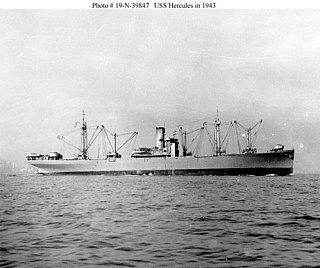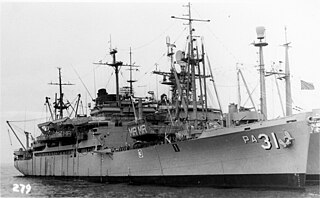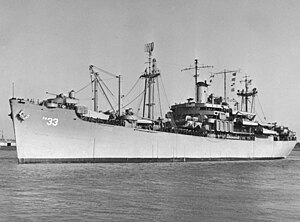
The Victory ship was a class of cargo ship produced in large numbers by American shipyards during World War II to replace losses caused by German submarines. They were a more modern design compared to the earlier Liberty ship, were slightly larger and had more powerful steam turbine engines, giving higher speed to allow participation in high-speed convoys and make them more difficult targets for German U-boats. A total of 531 Victory ships were built in between 1944 and 1946.

A troopship is a ship used to carry soldiers, either in peacetime or wartime. Troopships were often drafted from commercial shipping fleets, and were unable to land troops directly on shore, typically loading and unloading at a seaport or onto smaller vessels, either tenders or barges.

The Bogue class were a class of 45 escort carriers built in the United States for service with the US Navy and the Royal Navy, through the Lend-Lease program, during World War II. Following the war, ten Bogue-class ships were kept in service by the US Navy and were reclassified for helicopter and aircraft transport operations.

Attack transport is a United States Navy ship classification for a variant of ocean-going troopship adapted to transporting invasion forces ashore. Unlike standard troopships – often drafted from the merchant fleet – that rely on either a quay or tenders, attack transports carry their own fleet of landing craft, such as the landing craft, vehicle, personnel (LCVP) or Higgins boat.

Haskell-class attack transports (APA) were amphibious assault ships of the United States Navy created in 1944. They were designed to transport 1,500 troops and their combat equipment, and land them on hostile shores with the ships' integral landing craft.

The Artemis-class attack cargo ships were a series of attack cargo ships (AKAs) built by Walsh-Kaiser Company of Cranston and Providence, Rhode Island, during World War II.

The Arcturus-class attack cargo ships were converted from other ship types by Sun Shipbuilding & Drydock Co. in Chester, Pennsylvania, Tampa Shipbuilding Co. in Tampa, Florida, and Federal Shipbuilding & Drydock Co. in Kearny, New Jersey, during World War II.

The 3"/50-caliber gun in United States naval gun terminology indicates the gun fired a projectile 3 inches (76 mm) in diameter, and the barrel was 50 calibers long. Different guns of this caliber were used by the U.S. Navy and U.S. Coast Guard from 1900 through to 1990 on a variety of combatant and transport ship classes.

Type C3-class ships were the third type of cargo ship designed by the United States Maritime Commission (MARCOM) in the late 1930s. As it had done with the Type C1 ships and Type C2 ships, MARCOM circulated preliminary plans for comment. The design presented was not specific to any service or trade route, but was a general purpose ship that could be modified for specific uses. A total of 162 C3 ships were built from 1939 to 1946.

USS Grafton (APA-109) was a Bayfield-class attack transport which served with the United States Navy from 1945 to 1946. She was sold into commercial service in 1947 and was scrapped in 1975.

The Gilliam-class attack transport was a class of attack transport built for service with the US Navy in World War II.
The Western Pipe and Steel Company (WPS) was an American manufacturing company that is best remembered today for its construction of ships for the Maritime Commission in World War II. It also built ships for the U.S. Shipping Board in World War I and took part in the construction of the giant Grand Coulee Dam project in the 1930s.

USS Callaway (APA-35) was a Bayfield-class attack transport that served with the US Navy, and was manned by the United States Coast Guard during World War II.

The Windsor-class attack transport was a class of nine US Navy attack transports. Ships of the class saw service in World War II.

The Ormsby-class attack transport was a class of US Navy attack transport that saw service in World War II.

The Crescent City-class attack transport was a class of U.S. Navy attack transports that saw service in World War II and the Korean War. There were four ships in the class: USS Crescent City, USS Charles Carroll, USS Monrovia, and USS Calvert.

The Harris-class attack transport was a class of US Navy attack transport which saw service in World War II. The purpose of any attack transport was to deliver troops and their equipment to hostile shores in order to execute amphibious invasions using an array of smaller integral landing craft. Being intended to serve in forward combat areas, these ships were well armed with antiaircraft guns to protect itself and its vulnerable cargo of troops from air attack in the battle zone.

The Heywood-class attack transport was a class of US Navy attack transport built in 1919 that saw service in World War II.

The Doyen-class attack transport was a class of two attack transports that saw service with the US Navy in World War II. Ships of the class were named after generals of the United States Marine Corps.

The T3 tanker, or T3, are a class of seaworthy large tanker ships produced in the United States and used to transport fuel oil, gasoline or diesel before and during World War II, the Korean War and the Vietnam War. The T3 tanker classification is still used today. The T3 tanker has a full load displacement of about 24,830 tons.




















